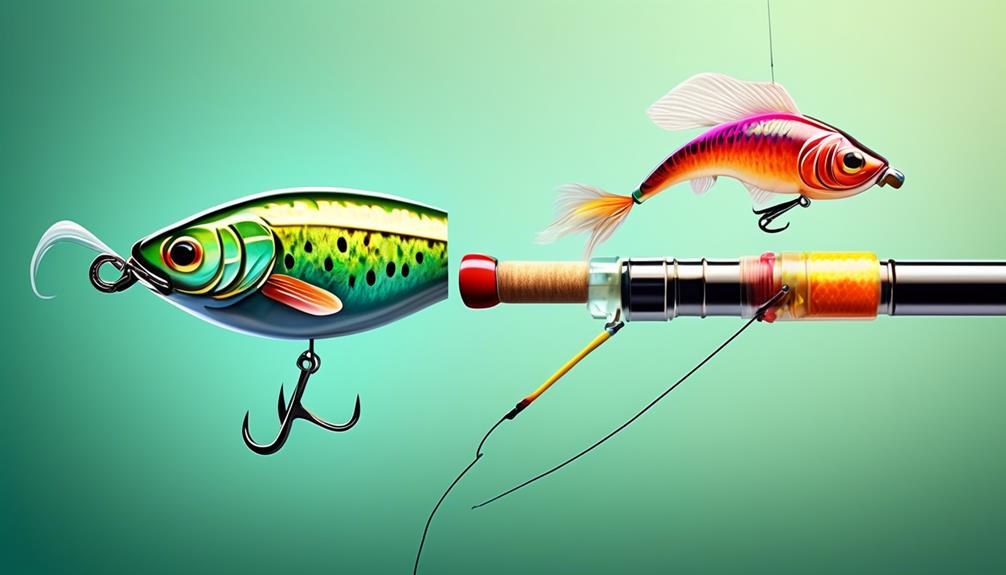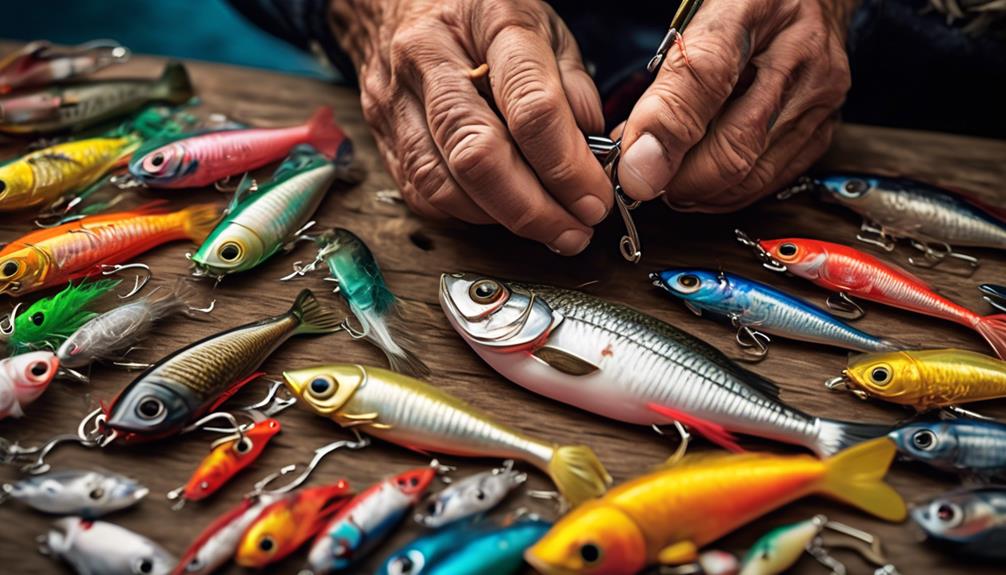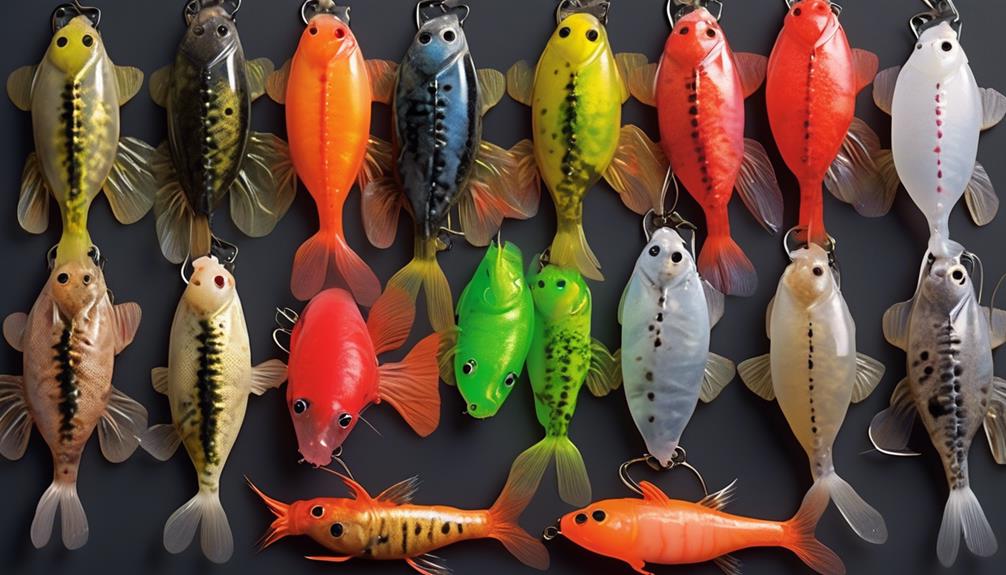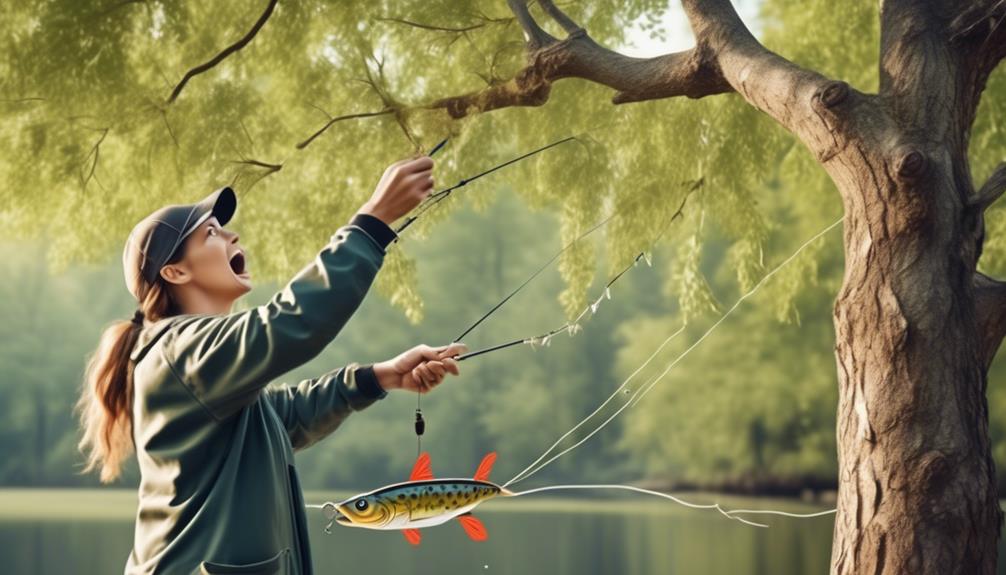So, you're out on the water, hoping to catch some big bass. You've got your trusty tackle box by your side, but now comes the big decision: should you use a flashy fishing lure or opt for live bait?
It's a debate as old as fishing itself, and there are valid arguments for both sides. When it comes down to it, effectiveness is the key factor. But which is more effective – the artificial allure of a well-crafted lure or the natural appeal of live bait?
It's a question that has sparked countless discussions among anglers, and we're here to help you weigh the pros and cons of each to make an informed decision for your next fishing trip.
Pros and Cons of Fishing Lures
When choosing fishing lures, it's important to consider the advantages and disadvantages they offer for different fishing scenarios. Lure design plays a crucial role in attracting fish. Different designs mimic various types of prey, such as minnows, insects, or crustaceans. For example, topwater lures are designed to resemble injured baitfish, creating surface commotion to attract predatory fish. On the other hand, diving lures are crafted to mimic swimming prey, diving to specific depths to entice fish. Understanding the behavior of the target fish and the prevailing conditions is essential in selecting the most effective lure design.
Lure color is another critical factor in lure effectiveness. The color of a lure should match the prevailing water conditions and the natural prey of the fish being targeted. In clear water, natural and translucent lure colors like silver, gold, and various shades of green and blue are effective. In murky or stained water, bright and bold colors such as chartreuse, orange, and red are more visible to fish. However, it's essential to note that the effectiveness of lure color can vary depending on factors such as light conditions and the specific behavior of the fish species being targeted.
Considering both lure design and color when selecting fishing lures can significantly improve your chances of enticing fish to bite. Understanding the nuances of these factors and adapting your lure choice to the specific fishing conditions will maximize your success on the water.
Benefits of Using Live Bait
Using live bait offers several advantages when fishing. One advantage is that live bait presents a natural and enticing meal to fish, increasing the chances of attracting bites. The lifelike movement and scent that live bait produces can be more appealing to fish compared to artificial lures. The natural appearance and scent of live bait can trigger a strong feeding response in fish, making them more likely to strike. Live bait can also be more effective in enticing wary or selective fish that may be less inclined to go after artificial lures.
Another advantage of live bait techniques is their versatility. With live bait, you can vary the presentation by adjusting the depth, speed, and movement, allowing you to adapt to changing fishing conditions and fish behavior. This adaptability can be particularly advantageous when targeting various species or when fishing in different environments.
Furthermore, using live bait allows you to target a wider range of fish species. Many predatory fish species naturally feed on live prey, so using live bait increases the likelihood of attracting a diverse array of fish. Whether you're targeting bass, trout, walleye, or other game fish, live bait can be highly effective in enticing a bite.
Types of Fishing Lures
Frequently, anglers rely on a variety of fishing lures to entice fish into striking, each designed to mimic the appearance and behavior of natural prey. When choosing the right fishing lure, it's important to consider various factors such as the type of fish you're targeting, the fishing conditions, and the behavior of the prey.
Here are some popular fishing lure styles and lure color choices to consider:
- Fishing Lure Styles
- Jigs: Versatile and effective for various fish species, jigs are designed to mimic injured baitfish or prey on the bottom of the water.
- Spinnerbaits: These lures have spinning blades that create vibration and flash, making them ideal for murky waters and attracting predatory fish.
- Crankbaits: Ideal for covering a large area and mimicking the erratic movement of injured fish, crankbaits come in various diving depths to target different fish habitats.
When it comes to lure color choices, it's essential to consider the water clarity and the natural prey in the area. In clear water, natural and translucent colors like silver, green, and brown can be effective. In murky or stained water, bright and contrasting colors such as chartreuse, orange, and red can help the lure stand out and attract fish.
Understanding the different fishing lure styles and selecting the right colors based on the fishing conditions can significantly improve your chances of enticing fish to strike.
Choosing the Right Live Bait
Selecting the appropriate live bait is crucial to maximizing your chances of a successful fishing trip. When it comes to selecting bait, there are several alternatives to consider, each with its own advantages depending on the type of fish you're targeting and the fishing conditions.
One of the most popular live baits is the nightcrawler. Nightcrawlers are large earthworms that are readily available at bait shops. They're effective for catching a wide variety of fish species, including trout, bass, and panfish.
Another popular option is minnows, which are particularly effective for catching predatory fish such as walleye, pike, and muskie. Additionally, if you're targeting saltwater species, shrimp and squid are excellent live bait options.
When choosing live bait, it's essential to consider the natural prey of the fish you're attempting to catch. For example, if you're targeting bass in a lake with a lot of crawfish, using a live crawfish as bait could be highly effective. Similarly, if you're fishing for catfish, using live bait such as worms, minnows, or even chicken livers can yield great results.
Keep in mind that the availability of live bait can vary depending on your location and the time of year. It's always a good idea to check with local bait shops or fellow anglers to determine the most effective live bait options for the specific fishing conditions you'll be facing.
Effectiveness of Fishing Lures
When fishing, consider the effectiveness of fishing lures as an alternative to live bait for attracting and catching various fish species. Fishing lures offer several advantages that make them a compelling choice for anglers of all skill levels.
Here are a few key points to consider:
- Catch Rates: Fishing lures can often lead to comparable catch rates as live bait, especially when used strategically in different fishing environments. Certain lures are designed to mimic natural prey, effectively enticing fish to strike. Additionally, lures allow anglers to cover more water efficiently, increasing the chances of encountering active fish.
- Convenience: Using fishing lures eliminates the need to handle live bait, making the fishing experience more convenient and less messy. Lures also have the added benefit of being reusable, saving time and effort spent on acquiring fresh live bait before each fishing trip.
- Attractiveness and Versatility: Fishing lures come in a wide variety of colors, shapes, and sizes, allowing anglers to choose the most attractive option based on the target species and prevailing conditions. Furthermore, lures can be used across different fishing techniques, including casting, trolling, and jigging, making them incredibly versatile tools for anglers seeking to diversify their fishing approach.
Considering the catch rates, convenience, attractiveness, and versatility of fishing lures, it's evident that they're a highly effective and practical choice for anglers looking to enhance their fishing experience and maximize their chances of success.
Live Bait Presentation Techniques
To effectively present live bait, consider adjusting your rigging and casting techniques to maximize its natural appeal to the target fish species.
When comparing live bait vs artificial lures, bait presentation skills play a crucial role in enticing the fish to strike. One of the most important aspects of live bait presentation is to ensure that the bait looks as natural as possible in the water. This means avoiding any unnatural movements that might spook the fish.
When rigging live bait, it's essential to hook it in a way that allows it to swim freely and appear lively. For example, when using live minnows, hooking them through the lips or back allows them to swim more naturally, making them irresistible to predatory fish.
In addition to rigging, casting techniques also influence the presentation of live bait. When casting with live bait, it's important to make gentle and accurate casts to avoid causing unnecessary stress to the bait. A gentle landing on the water helps maintain the natural appearance and behavior of the live bait. Furthermore, casting near structures or areas where fish are likely to be present can increase the chances of a successful presentation.
Cost Comparison: Lures Vs Live Bait
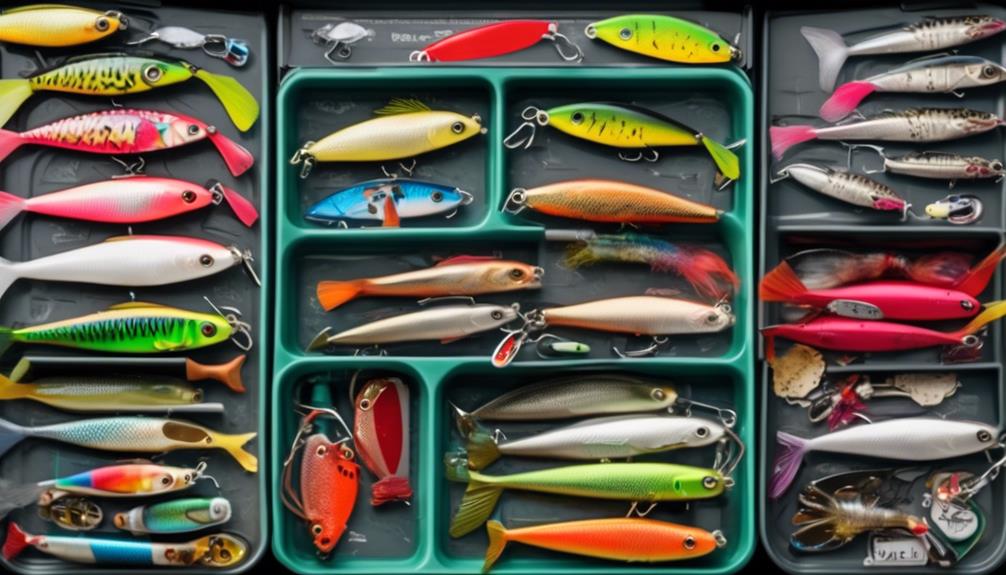
Considering the factors that influence bait presentation, it's important to now assess the cost comparison between using lures and live bait for fishing. When deciding between fishing lures and live bait, it's crucial to take into account the cost implications and the longevity of the bait. Here's a breakdown to help you make an informed decision:
- Cost Comparison
- Fishing Lures: While there's an initial investment in purchasing lures, they're reusable and can last for multiple fishing trips if not lost or damaged. This makes them a cost-effective option in the long run.
- Live Bait: Live bait, such as worms, minnows, or shrimp, may need to be purchased before each fishing trip, resulting in ongoing expenses. The cost can add up, especially if the bait isn't used entirely and can't be stored for future use.
- Bait Longevity
- Fishing Lures: Lures are designed to be durable and can withstand multiple uses. As long as they aren't lost or damaged, they can be used repeatedly, providing good value for their cost.
- Live Bait: The longevity of live bait is limited, as it can perish or become ineffective if not used promptly. This means that any leftover live bait from a fishing trip may go to waste, impacting the overall cost.
When factoring in cost comparison and bait longevity, it becomes evident that fishing lures offer a more cost-effective and sustainable option for avid anglers.
Environmental Impact of Lures and Live Bait
Using fishing lures instead of live bait can reduce the environmental impact of fishing by minimizing the need for harvesting live organisms from natural habitats. This practice promotes environmental sustainability by decreasing the direct impact on wildlife and the overall ecosystem balance.
Lures are typically made from materials such as plastic, wood, or metal, which can be reused multiple times, unlike live bait, which often involves the harvesting of small fish or other organisms from their natural habitats. By reducing the demand for live bait, conservation efforts are supported, allowing for a more balanced and sustainable approach to fishing.
The use of live bait can have a significant impact on wildlife and ecosystem balance. Harvesting live bait can disrupt the natural food chain, affecting the populations of various species. Additionally, the depletion of live bait organisms can lead to imbalances in the ecosystem, potentially impacting other wildlife dependent on these organisms for food. This disruption can have far-reaching effects, not only on the targeted fish species but also on the broader aquatic environment.
In contrast, fishing lures don't contribute to these disruptions. By using lures, anglers can enjoy the sport of fishing while minimizing their impact on the environment. This approach aligns with conservation efforts and supports the long-term health of aquatic ecosystems.
Ultimately, choosing lures over live bait can make a positive difference in preserving the delicate balance of marine and freshwater environments.
Frequently Asked Questions
Can Using Fishing Lures or Live Bait Affect the Taste of the Fish When Cooking?
Using fishing lures or live bait won't directly affect the taste of the fish when cooking. The flavor profile is more influenced by cooking techniques and seasoning choices.
However, it's essential to consider your culinary and taste preferences when deciding between lures or live bait for fishing.
Ultimately, the freshness and quality of the fish, along with your cooking skills, will have a more significant impact on the final taste when preparing your catch.
Are There Any Specific Regulations or Restrictions on Using Fishing Lures or Live Bait in Certain Fishing Areas?
When fishing in different areas, regulations and restrictions may apply to the use of fishing lures or live bait. It's essential to check local guidelines for specifics on permitted fishing techniques and bait presentation.
Some areas may have restrictions to protect wildlife and conserve the environment. Always be aware of the specific rules for fishing lures and live bait in the fishing areas you plan to visit.
How Do Different Weather Conditions Affect the Effectiveness of Fishing Lures Versus Live Bait?
In different weather conditions, the effectiveness of fishing lures versus live bait can vary. The temperature affects fish behavior, impacting their response to bait presentation. Additionally, water clarity plays a role, with lures being more visible in clear water.
Live bait can be more effective in colder temperatures, while lures may work better in warmer conditions. Understanding these factors and adjusting your approach accordingly can improve your fishing success.
Are There Any Ethical Considerations When Choosing Between Using Fishing Lures or Live Bait?
When deciding between fishing lures or live bait, it's important to consider ethical considerations like environmental impact and animal welfare.
Using live bait can raise concerns about the well-being of the baitfish, while lures may have less impact on the environment.
Both methods have their ethical considerations, so it's crucial to make an informed choice based on your values and the impact you want to have on the ecosystem.
What Are Some Common Mistakes Anglers Make When Using Fishing Lures or Live Bait, and How Can They Be Avoided?
When using fishing lures or live bait, common mistakes like using the wrong size or color can impact your success. Avoid this by matching the lure to natural prey and adjusting based on water conditions.
Angler preferences and fishing techniques vary, so it's important to adapt.
Additionally, not paying attention to the movement of the bait can be a mistake. Ensure you're using the right technique to mimic natural prey and attract fish effectively.
Conclusion
In conclusion, both fishing lures and live bait have their strengths and weaknesses.
Fishing lures offer versatility and convenience, while live bait provides a natural and enticing presentation.
Ultimately, the effectiveness of each method depends on the specific fishing conditions and the preferences of the angler.
It's important to consider factors such as cost, environmental impact, and the behavior of the target fish when deciding between fishing lures and live bait.
Happy fishing!
